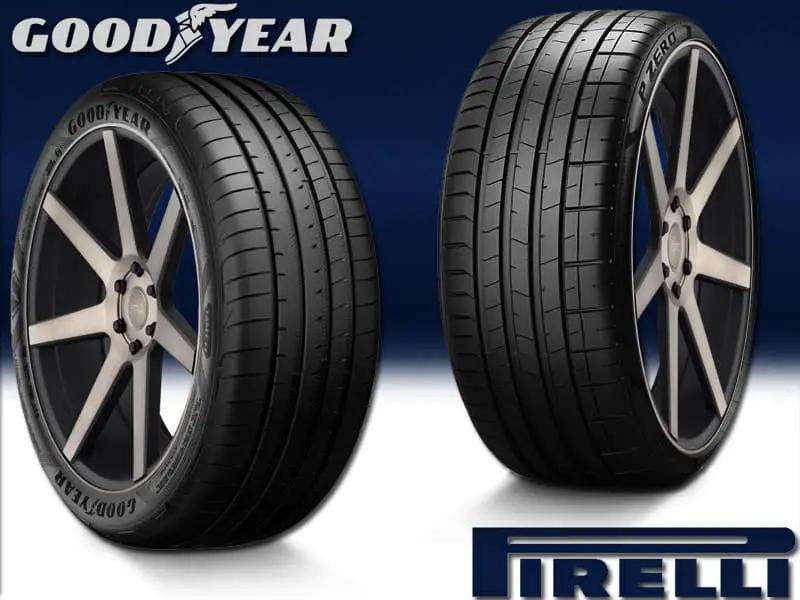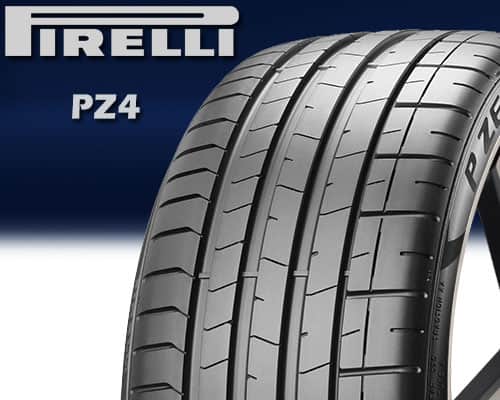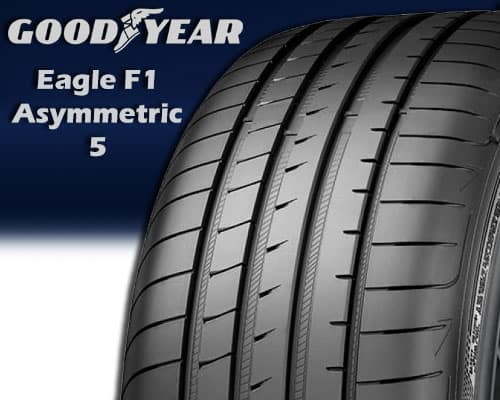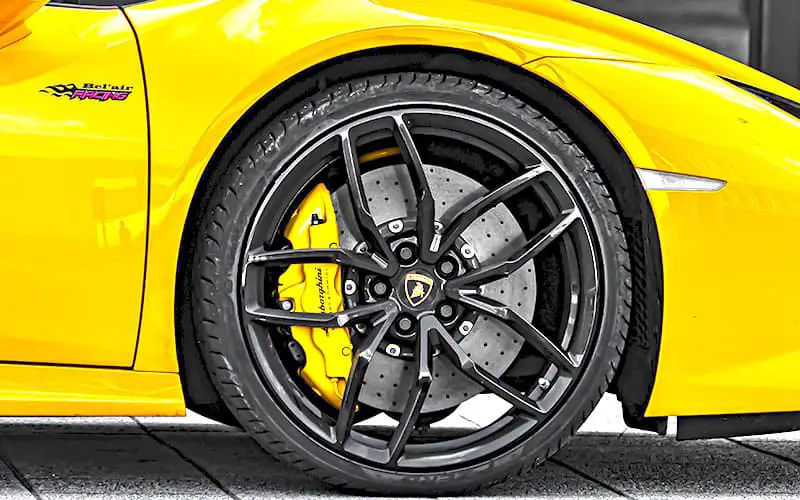Both the Pirelli P Zero PZ4 and the Goodyear Eagle F1 Asymmetric are high-performance summer tires that are designed to give enhanced steering and braking capabilities in a warm climate.
PZ4 has a lower void ratio, which allows for more contact on the road, resulting in improved dry traction, while Asymmetric 5 has a higher void ratio, providing better wet traction and helping to avoid hydroplaning.

The PZ4’s dry grip and handling are also far better than that of Asymmetric 3 due to its higher contact patch.
Lets compare P zero with both variants of Eagle F1:
Table of Contents
Comparing Pirelli PZ4 with Goodyear Eagle F1 Asymmetric 5

Vs

PZ4 has an asymmetrical tread pattern with a lower void ratio which allows a larger contact area with the road. The tire’s higher contact patch allows it to grip the road more effectively, and its enhanced shoulder design improves the handling, increasing its overall traction on the road in dry situations. It performs well on wet roads as well, because of its large contact area and numerous sipes.

However, it struggles in flooded conditions due to its narrow grooves which are unable to wipe enough water. Since it has more contact with the road, therefore, its treadwear is higher and it is not expected to deliver higher mileage.
The Asymmetric 5 tire also has an asymmetrical design with a slightly higher void ratio, which reduces the tire’s contact patch. Due to the smaller contact area and the unoptimized shoulder design, the tire is slightly less capable on the road in terms of dry grip and handling. It also compromises traction on wet surfaces due to fewer sipes, but its hydroplaning resistance is exceptional due to the presence of wider grooves. Due to less contact with the road, it has a lower rolling resistance which allows higher durability and mileage. Because of its wider grooves, it is noisier and makes the journey more uncomfortable.
Road Grip Comparison

PZ4 has more contact with the road, allowing greater grip. On a dry road, the tire performance is determined by its barking distance. The dry braking distance of the PZ4 is 109.3 feet, which is considerably better than the rest of the tires in the same category. In addition to the contact patch, the tire sipes have a vital role in wet gripping. PZ4 has a 112.5 feet wet braking distance, which is higher than its rival, making the tire lack on wet roads.
The asymmetric 5 tire has less contact with the ground which decreases its grip on dry roads. It has a 112.4 feet dry braking distance, which is near to that of its opponent. So, both provide adequate dry on-road grip, but the PZ4 is somewhat better because of its shorter dry braking distance. The Asymmetric 5 tire has numerous sipes along with a smaller contact area. It has average wet traction on the road. It has a wet braking distance of 110.5 feet which is nearly comparable to its counterpart but is slightly lower compared to PZ4 This tire is the most effective for wet traction and is considered the best option.
Handling Comparison of the tires
PZ4 has wider grooves on its shoulders, providing a comparatively lower contact patch, therefore, it has a slightly lower dry handling average speed of 59 mph. As a result, allow good on-road dry handling but marginally lesser than Asymmetric 5. Due to the lack of sipping on its shoulders, its average wet handling speed is 40.3 mph, which is much lower than its opponent.
Asymmetric 5 has a closed shoulder design, providing a higher contact patch, thus, allowing a dry handling speed of 59.5 mph, which is remarkable when compared to the PZ4 tire. The deeper sipes on the shoulders aid in maintaining a grip on wet roads, the Asymmetric 5’s wet handling average speed of 40.5 mph puts it ahead of its counterpart, barely.
Comparison of Hydroplaning Resistance
The term “hydroplaning” refers to a situation in which the tire lost contact with the road due to a significant amount of water between them. The tire with broader voids can readily travel through the water while maintaining road grip. Unfortunately, the grooves on PZ4 are narrow, allowing only a floating speed of 45 mph.
In comparison, the grooves on the Asymmetric tire are wider and deeper, providing more space for the flow of water than its counterpart, resulting in a much better tire on flooded roads with a float speed of 48 mph, making it a superior tire in such conditions.
Comparison of Rolling Resistance
The force required to keep the tire rolling is known as rolling resistance. PZ4 tire has a higher contact, causing more friction. The higher the friction, the higher the amount of force will be required to overcome it. As a result, the tire has a significantly higher rolling resistance of 9.44 kg t than the other tire.
Due to its slightly lower contact patch, the Asymmetric 5 tire has a lower rolling resistance of 9.31 kg t, which means lesser tread will engage with the ground, which reduces the friction, thus, the energy requires to keep the tire moving.
Comfort and Noise Comparison
High-performance automobile tires are usually noisy but the PZ4 has an external noise level of 70.7 decibels. Lower interior noise levels are achieved because of unique grooves in the tread region.
The noise reduction performance of the Goodyear Eagle F1 Asymmetric 5 is excellent, making driving quiet and comfortable for passengers. It has an exterior noise level of 71.1 decibels.
Durability and Treadwear Differences
PZ4 tires have unique silica and carbon black tread combination, leading to softer tires in comparison. It may perform well on the road in terms of grip and handling, but due to its softer tread and higher rolling resistance, the tire will quickly wear out. This reduces the tire’s durability and allows it to achieve significantly lower mileage.
Asymmetric tire, on the other hand, has a strong frame and an internal construction that includes twin steel belts reinforced by spirally wrapped polyamide cord cap plies, which improves the tire constructed quality and tread wear resistance. The tire has a slightly tougher tread rubber, which reduces the tire’s grip and handling but allows it to be used for a longer period. The lower rolling resistance leads to increased durability and strength of the tire.
Price Differences
Due to higher durability and mileages along with better wet traction, the Asymmetric tire is more highly-priced than its counterpart PZ4 which provides good dry traction but lower durability and mileages.
Comparing Pirelli PZ4 with Goodyear Asymmetric 3

Vs

The PZ4 has an asymmetrical tread design with 5 columns separated by 4 grooves which are wide, except for the fourth one which is thin as a line. There are 2 ribs and 1 tread block column in this tire. Lateral grooves define its shoulder blocks and also separate the blocks in the tread column. They also cut through the ribs and tread blocks column passing through the second and third circumferential groove. Small length sipes are present on both the ribs and column blocks but they aren’t found on the shoulders.
On the other side, the Asymmetric 3 has a 5 pitch tread design with 4 circumferential grooves. Two of these grooves are wide, one is medium in length and the fourth one is the narrowest. Deep sipes define its shoulders and contain no lateral grooves. Two ribs are featured with thin sipes on one of the ends, along with a tread blocks column where the blocks are separated by the sipes.
Grip Comparison
The PZ4 has a comparatively higher contact patch. This offers more contact with the road, resulting in a higher grip. However, the exceptional dry grip of the PZ4 is not translated into the wet grip. That’s because there are fewer sipes on its tread than on its competitor. As a result, the tire’s wet braking distance increases, and its grip on wet roads is compromised.
As for the Asymmetric 3, it has wider grooves which reduce the efficiency of this tire on dry roads. Due to the wider grooves, its contact patch is limited and as a result, the overall traction on paved roads is reduced. As the traction reduces, the braking distance also increases. Coming to the tire’s performance on wet roads, it handles the wet weather well. The frequent sipes present on the tread maintain a firm grip on the wet roads, even at high speed.
Handling Comparison
Dry handling is also an area where the PZ4 beats the Asymmetric 3. To enhance the tire’s performance on dry roads, it comes with specialized shoulder blocks. The outer shoulder of the tire has a serrated, closed pattern which allows the tire to grip well on road even through sharp turns, resulting in greater handling. Talking about the wet handling, the PZ4 also seems to be much better. The sipes pattern found on the shoulder along with deep cuts enables the tire to steer better on wet roads as well.
On the other hand, the Asymmetric 3 consists of wider grooves on its shoulders. As a result, its grip decreases. Therefore, it’s handling on dry roads is compromised to some extent. The handling on wet surfaces is also reduced due to the lesser number of sipes on its shoulders.
Comparison of Hydroplaning Resistance
The hydroplaning resistance of the PZ4 is relatively lower. This tire has narrower grooves as compared to its competitor. This puts the tire at risk of hydroplaning since it can’t effectively wipe away the water and the vehicle might lose control.
Comparatively, the Asymmetric 3 has pretty good resistance to hydroplaning due to their wider grooves. The design and the tread depth of the tire make it easier to evacuate water effectively while maintaining the speed. Thus, the tire is capable of offering good grip and control even in wet conditions at high speed. This is what makes it a suitable choice for rainy seasons.
Comparison of Rolling Resistance
The Pirelli tire has higher rolling resistance due to its higher contact patch. The higher contact patch causes there to be more friction between the tread and the road, this increases the energy required to overcome this friction. Therefore, a large quantity of fuel is utilized, decreasing the tire’s fuel efficiency.
On the other hand, the Goodyear Eagle F1 has an incredibly low rolling resistance. This means that this tire is more efficient than its competitor. That’s because since the tire has less contact patch with the road so it will require less energy to roll. To put it in simple words, the more the grip of the tire, the more energy the tire will require to roll.
Durability & Treadwear
Talking about durability and treadwear, the Pirelli P Zero PZ4 is a tire that is more prone to wear and tear due to more contact patch. The average range of miles that you can get from these tires is around 30,000 miles. However, it might also depend upon the condition in which you drive. Certain built-in protective features in the tire prolong its tread life such as the thickened sidewalls and rim protector. These features will protect the tire against scratches. However, when the tire does wear, it will be molded into a multi-radius shape that will result in an even wear.
In comparison, the Asymmetric 3 is a higher durable tire. That’s because of its lower rolling resistance as compared to the PZ4’s. As a result, its treadwear is also lower. Its high durability is made possible due to the rigid frame of the tire along with its internal structure which consists of a twin belt that is reinforced by polyamide cord cap piles. Therefore, the tire stands up to its reputation and resists treadwear extremely well.
Price
Pirelli and Goodyear products are both considered the top in the industry. However, the PZ4 costs a bit more than its competitor due to its excellent dry grip and handling. On the other hand, the Asymmetric 3 is a more affordable tire that offers lower rolling resistance and excellent durability.